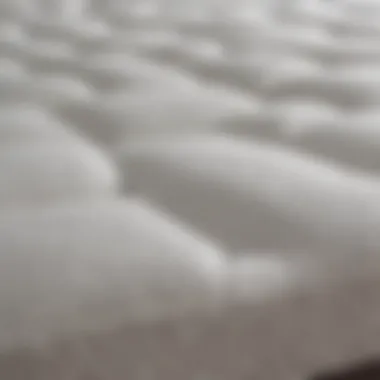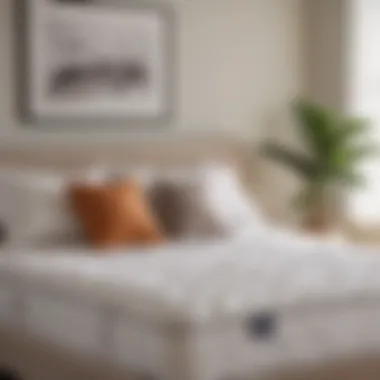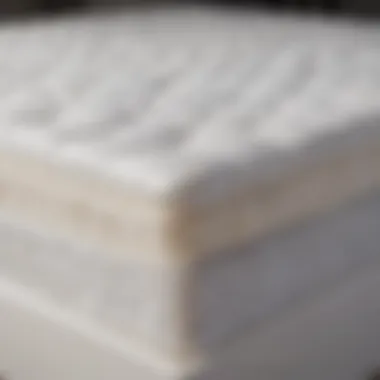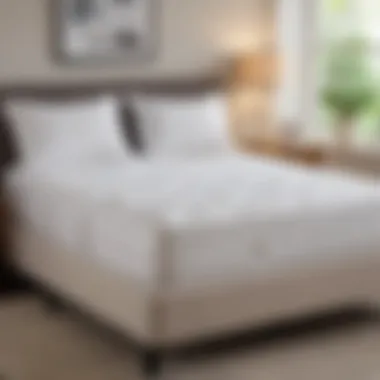Essential Insights on Short Queen Mattress Protectors


Intro
In the realm of bedding accessories, a mattress protector might seem like a mere afterthought, yet it plays an essential role in enhancing both comfort and longevity of your sleep surface. A short queen mattress protector, tailored for those who enjoy its particularity, is a cornerstone for anyone keen on preserving their mattress investment. This article aims to provide an in-depth exploration of short queen mattress protectors, focusing on their construction, benefits, maintenance, and tips for selection.
Understanding the significance of this bedding accessory not only enlightens homeowners but also serves designers and renters looking to elevate their sleeping experience. Given the growing interest in optimal home design and functionality, it's high time we dissect the merits of integrating the short queen mattress protector into various living situations.
In a world where convenience often trumps quality, making informed decisions regarding bedding can set the stage for those nightly retreats we all crave. Whether you're investing in a new mattress or simply enhancing an existing one, knowing what to look for in a mattress protector can save you headaches down the line.
Understanding the Short Queen Mattress Protector
In the realm of bedding accessories, the short queen mattress protector often stands as an unsung hero. This essential component not only serves as a barrier between your mattress and the elements but also plays a pivotal role in enhancing your sleep experience. Taking the time to understand what a short queen mattress protector can offer is crucial for anyone looking to preserve their investment in a good night's sleep.
First and foremost, let’s nail down what exactly a short queen mattress protector is. For those new to the world of mattresses, the short queen measures 60 inches wide by 75 inches long. This size is particularly popular among RV dwellers and smaller bedroom setups where space is at a premium. Given the unique dimensions, finding accessories that fit just right can be a bit of a challenge, making knowledge surrounding short queen protectors all the more important.
A Few Benefits to Consider
Using a mattress protector goes way beyond just covering an investment. Here are some prime benefits that make them indispensable:
- Protection Against Accidents: Whether it's a spilled drink or an unexpected pet mess, these protectors act as a first line of defense, thwarting stains that could ruin your mattress.
- Comfort Enhancement: Many protectors are designed with materials that add an extra layer of comfort, contributing to a more restful sleep.
- Allergy Reduction: Mattress protectors trap dust mites and other allergens, offering a haven for those sensitive to these pests.
Moreover, given the critical role of a mattress protector in prolonging the lifespan of your bedding, investing in a quality product may seem expensive upfront but pays off in the long run.
Key Considerations
When weighing the options, you should consider the level of protection and comfort you need. This can range from basic fabric protectors, which may be water-resistant but not entirely waterproof, to specialized ones that are breathable while boasting a full-on waterproof barrier.
"A quality mattress protector is not just an accessory; it's an investment in one’s health and sleep quality."
Understanding these aspects can guide you to making informed choices. Ultimately, whether you are a homeowner, renter, designer, or simply someone looking for a good night’s sleep, grasping the nuances of short queen mattress protectors is vital. It sets the stage for not only protecting your mattress but equally ensuring your sleep environment is conducive to rest and recovery.
Defining Short Queen Dimensions
As briefly mentioned before, the short queen size, measuring 60 inches wide and 75 inches long, fits a specific niche in the mattress market, particularly appealing to those with limited space. These dimensions not only cater to RV setups but also can attract people living in studio apartments or smaller guest rooms. Understanding these measurements can help in selecting the right mattress protector that fits snugly without excess fabric bunching up at the corners.
It's quite easy to misjudge dimensions. For example, many assume a queen mattress will fit comfortably in all spaces. However, the short queen is designed for those needing a more compact solution. This brings us to the next logical question: how do these dimensions compare to other sizes?
Differences Between Mattress Sizes
When it comes to mattress sizes, clarity is key. The vast array of options can be overwhelming:
- Standard Queen: Generally 60 inches by 80 inches, a standard queen is a full five inches longer than its short counterpart.
- Twin: Coming in at 38 inches by 75 inches, a twin size is useful for bunk beds or small children's rooms.
- Full: Slightly larger than a twin but smaller than a queen, measuring 54 inches by 75 inches. This size is ideal for individuals or couples in cozy spaces.
In essence, while a traditional queen provides ample space for two sleepers, the short queen becomes a preferred choice for smaller sleeping quarters, where every inch matters. This difference underscores the importance of knowing the exact dimensions of your bedding, as misplaced assumptions can lead to discomfort and even poor sleep posture. Plus, ensuring the right fit with your protector will ultimately safeguard your mattress effectively.
Exploring these distinctions not only helps you make an informed choice but also emphasizes the considerations pivotal to maintaining the integrity of your bedding. The layers of understanding developed through diving into dimensions and size differences ultimately enable you to select the most suitable short queen mattress protector, contributing to a restful, worry-free sleep.
Why Use a Mattress Protector?
Investing in a mattress protector is akin to putting on a seatbelt. At first glance, it may not seem absolutely crucial, but when those unexpected moments arise—be it a splash of juice or a sudden sneeze—you’ll be grateful for the extra layer of security. A mattress protector doesn’t just preserve your mattress against mishaps; it serves as a first line of defense against a range of issues that can diminish both comfort and the lifespan of your investment. Let’s unpack what makes this accessory so vital for homeowners, renters, and design enthusiasts alike.


Protection Against Stains and Spills
Think of a mattress protector as a shield for your mattress. Everyday life can bring surprises, from accidental spills during a late-night snack to pets jumping up with muddy paws. Without a protector, these stains can seep into the fabric and foam, leading to nasty odors and permanent discoloration.
"It’s much easier to toss a protector in the wash than to deal with a stained mattress!"
Some protectors are designed with specific properties, like liquid resistance, making them especially useful in households with children or pets. When you regularly encounter situations where spills are likely, these protectors can save you a heap of trouble. Not only do they keep your mattress looking fresh, but they also maintain hygiene, which is a no-brainer for a good night’s sleep.
Enhancing Mattress Lifespan
A high-quality mattress can be a hefty investment, often costing a pretty penny. To ensure you get your money’s worth, using a mattress protector is crucial. Every time you use your mattress, you subject it to wear and tear, and without protection, it ages at a faster rate.
Consider this: over time, everything from body oils to dust mites can accumulate, leading to the gradual degradation of the materials inside. A mattress protector acts like a barrier, absorbing some of this damage. By keeping your mattress cleaner and fresher for longer, you're saving yourself the hassle and expense of an early replacement. In other words, prevention is cheaper than cure.
Allergy and Pest Control
Allergies can make even the coziest bedroom feel like a battlefield. Dust mites, pet dander, and other allergens love to inhabit mattresses, creating an uncomfortable sleeping environment for sensitive individuals. A mattress protector, especially one that is allergen-resistant, can significantly alleviate these issues.
These protectors create a hypoallergenic barrier, blocking dust mites and other pests from infiltrating your mattress. Plus, they’re usually washable, allowing for easy maintenance to ensure that your bedding remains a sanctuary rather than a source of discomfort. For anyone struggling with allergies, a quality mattress protector can be a game changer in achieving restful slumber.
In summary, the benefits of a mattress protector extend well beyond simple aesthetics. They offer substantial protection from stains and spills, help prolong the lifespan of your mattress, and can enhance your sleeping environment by controlling allergens and pests. Investing in a solid protector means investing in your health, comfort, and peace of mind.
Material Considerations
When it comes to choosing a short queen mattress protector, what it's made of can significantly impact its performance and durability. Understanding material considerations ensures that homeowners, renters, designers, and even DIY enthusiasts make informed choices, ultimately leading to better sleep hygiene and comfort. Here, we dissect the various materials used in these protectors and their impacts on functionality.
Common Fabrics Used in Protectors
A variety of fabrics can be found in mattress protectors, each with its own unique qualities. Here are some common options:
- Cotton: Soft, breathable, and generally hypoallergenic, cotton is favored for its comfort. Cotton protectors can also absorb moisture well but may not be fully waterproof.
- Polyester: Often blended with cotton, polyester ensures durability and wrinkle-resistance. It has water-repellent qualities, making it a common choice in protectors.
- Tencel: Made from eucalyptus trees, Tencel offers excellent moisture-wicking properties. This fabric is eco-friendly and incredibly soft against the skin, promoting comfort and reducing heat retention.
- Vinyl and TPU: For those interested in waterproof properties, vinyl and thermoplastic polyurethane (TPU) are excellent choices. While they provide a thick barrier against liquids, they can trap heat, potentially affecting comfort.
In the material world, the fabric choice can either enhance or detract from the sleep experience, so it pays to know what works best for your individual needs.
Breathability and Comfort
Breathability is a key factor when selecting a mattress protector. Fabrics that allow air circulation can help regulate temperature and prevent overheating during sleep. A thick, non-breathable protector can hold heat, turning your bed into a veritable sauna - not exactly the restful environment you might be dreaming of.
Consider the following elements:
- Moisture-Wicking Properties: Fabrics like cotton and Tencel are not only breathable but also wick moisture away from the body, which can be essential for those who tend to perspire during the night.
- Construction: The way the fabric is woven also matters. A looser weave enhances airflow, while a tighter weave offers better protection but may impact breathability.
If you’re one to toss and turn, a highly breathable material might be your best bet. Choosing wisely can make all the difference in achieving undisturbed sleep and waking up refreshed.
Waterproof vs. Water-Resistant Options
One pressing question that frequently arises is whether to choose a waterproof or water-resistant mattress protector. Each serves a purpose, but they do differ in functionality and practicality.
- Waterproof: As the name implies, this option truly acts as a barrier against all liquid. Ideal for households with children or pets, waterproof protectors are typically made with vinyl or TPU layers. They can endure spills and accidents hands-down, but keep in mind they might lack some of the breathability found in their water-resistant counterparts.
- Water-Resistant: These protectors repel liquid to a degree but aren’t completely impervious. They’re often softer and more breathable than waterproof models, which can appeal to those who prioritize comfort over absolute protection. A quick splash or a nightly spill? You’ll likely be safe, but deeper puddles may pose a problem.
So, what's the bottom line? Assess your lifestyle and preferences before making a decision. A protector that lacks adequate waterproofing could leave your mattress susceptible to unwanted stains, while one that is too rigid might compromise your sleep quality.


"Choosing the right material for your short queen mattress protector isn't just about protection; it's also about comfort and ensuring a good night's sleep."
Overall, material considerations play a pivotal role in maximizing the benefits of a mattress protector, whether for upkeep, comfort, or aesthetic appeal.
Choosing the Right Short Queen Mattress Protector
Selecting the right short queen mattress protector is no small feat. This crucial bedding accessory can greatly influence your overall sleep experience, longevity of your mattress, and even your health. With numerous options available on the market, understanding the right features and choices can be a bit overwhelming. However, it is vital to approach this task with a keen eye for detail.
Your choice of a mattress protector should align with your specific needs and preferences. Are you concerned about spills due to pets or young children? Perhaps allergies are your main worry? Or maybe, you’re simply looking to preserve your mattress for years to come? Whatever your situation might be, knowing what key aspects to focus on will help guide your decision.
Key Features to Look For
When it comes to short queen mattress protectors, certain features can make all the difference. Pay attention to the following:
- Material Type: Different fabrics offer various levels of protection and comfort. For instance, a cotton cover might be breathable, while a polyester option can provide more durability.
- Waterproofing: If you often find yourself dealing with spills or sweat, a waterproof version is essential. Make sure it’s labeled as waterproof, not just water-resistant.
- Fit and Elasticity: A stretchy protector ensures it fits snugly over your mattress without sliding off during the night.
- Noise Level: Some protectors can be quite crinkly, disturbing your peaceful slumber. Look for quiet materials if you seek an undisturbed rest.
"A good mattress protector should be like a good fence. It protects what you value behind it without drawing attention to itself."
Understanding Thread Count
The term thread count often creates confusion when shopping for mattress protectors. Simply put, it refers to the number of horizontal and vertical threads in a square inch of fabric. Higher thread counts can lead to softer and more durable fabric, but that isn't the complete story.
A thread count of 200 to 400 is generally acceptable for a quality protector. Keep in mind that a higher thread count may also make the material less breathable, which is crucial for a cozy night’s sleep.
Also, remember that the fabric weave and the type of yarn used also impact the feel and durability of the protector. Sometimes it's better to choose quality over quantity when it comes to thread count.
Price Range and Value Considerations
When considering a short queen mattress protector, the price can range widely.
- Budget Options: You can find decent protectors at around $20. However, expect them to lack some advanced features like waterproofing or high thread count.
- Mid-Range Choices: Ranging from $30 to $80, these protectors typically offer better materials and additional protection against spills.
- Premium Products: Prices can go over $80, featuring advanced technologies such as cooling fabric, high thread counts, and robust waterproof layers.
Make sure to weigh the features against the price. A lower-priced protector could save you money in the short run, but a higher-quality option might save you more in mattress replacement costs down the line. Investing in the right protector is about value, not merely cost.
In summary, when choosing your short queen mattress protector, consider your particular needs, the features that matter most to you, and the price-to-value ratio of the options available. Taking time to evaluate these elements could lead you to a choice that significantly enhances your sleep environment.
Maintenance and Care Tips
Caring for a short queen mattress protector goes beyond just tossing it on and calling it a day. A good protector is a shield, protecting your investment from dirt, spills, and wear. But just like any shield, it needs to be maintained well to do its job effectively. Regular maintenance not only prolongs the life of your mattress protector but also enhances your overall sleep experience.
Washing and Drying Recommendations
To keep your short queen mattress protector in top shape, proper washing and drying are fundamental. Most protectors are machine washable, but it pays to check the care label for specifics.
- Use Cold Water: Always opt for cold water. It helps prevent shrinking and maintains the integrity of waterproof membranes.
- Gentle Cycle: Use a gentle cycle to minimize wear and tear.
- Mild Detergent: A mild detergent will clean without causing too much friction.
- Avoid Bleach: While it may seem like a good option for stain removal, bleach can degrade fabric fibers over time.
When it comes to drying, if the label allows, consider the following tips:
- Air Dry: When possible, air-drying is the gentlest method. Hang it out to dry in a shaded area to avoid sunlight, which can fade colors.
- Tumble Dry Low: If you choose a dryer, keep the temperature low. High heat can damage waterproof layers, making them less effective.
These practices not only ensure cleanliness but also add years to the lifespan of your protector.


Stain Removal Techniques
Accidents happen, and that's precisely why you have a mattress protector. But don’t let stains become a permanent fixture. Quick action is crucial in stain removal. Here are effective techniques:
- Blot, Don't Rub: If a spill occurs, use a clean cloth to blot the area immediately. Rubbing can spread the stain or push it deeper.
- Use Mild Soaps: Mix mild soap with warm water and apply it to the stained area. Blot it gently with a cloth until the stain lifts.
- Odor Control: If odors linger after cleaning, sprinkle a bit of baking soda on the area and let it sit for a while before vacuuming.
For persistent stains, consider professional cleaning options specifically designed for mattress components. Sometimes, specialized attention is needed to maintain their functionality.
When to Replace Your Protector
No matter how well you maintain your mattress protector, there will come a time when replacement is the best option. Here are signs to watch out for:
- Visible Damage: If you notice tears, holes, or significant signs of wear, it’s time for a new one.
- Persistent Odors: A protector that retains smells, even after washing, may have absorbed too much and lost its efficacy.
- Increased Allergens: Over time, protectors can harbor dust mites and allergens. If allergies seem more pronounced, it may be time to upgrade your protector.
Replacing your short queen mattress protector at the right time ensures you continue to reap the benefits of cleanliness, comfort, and health. Overall, regular upkeep doesn't just protect your mattress; it enhances your sleep quality and well-being.
"An ounce of prevention is worth a pound of cure." - Benjamin Franklin
Being diligent about maintenance will enable you to enjoy the full benefits of your investment into a short queen mattress protector.
Environmental Considerations
The focus on environmental considerations in the realm of short queen mattress protectors is not just a passing trend; it’s a crucial dialogue in today's society. As homeowners, renters, and designers become increasingly aware of the ecological impact of their purchases, understanding the role of eco-friendly materials and sustainable manufacturing practices in mattress protectors becomes vital. This segment digs into these dimensions, offering insights into how consumers can make choices that are not only beneficial for their own needs but also for the planet.
Eco-Friendly Materials and Certifications
When shopping for a short queen mattress protector, one of the primary aspects to consider is the materials used in construction. Select products made from organic cotton, which is produced without harmful pesticides and fertilizers. Options like bamboo-derived rayon are growing in popularity too, thanks to their natural moisture-wicking properties and biodegradability. These materials not only confer comfort but are also kinder to the environment, reducing the carbon footprint associated with synthetic fibers.
It’s also prudent to look for certifications that indicate responsible sourcing. Certifications like GOTS (Global Organic Textile Standards) or OEKO-TEX assure consumers that the textiles meet strict environmental and safety standards. This level of transparency facilitates informed decision-making.
"Opting for eco-friendly mattress protectors looks after your well-being and the health of the planet."
Sustainable Manufacturing Practices
Manufacturing processes can have far-reaching implications for the environment. Short queen mattress protectors crafted through sustainable methods feature innovations that minimize waste and energy consumption. For instance, companies that implement low-impact dyeing techniques reduce water pollution and energy use compared to traditional methods. Some manufacturers are now utilizing renewable energy sources—such as solar or wind power—in their production processes, which significantly lessens reliance on fossil fuels.
Besides, brands that prioritize fair labor practices also align with a more sustainable ethos. By supporting companies that ensure fair wages and safe working conditions, consumers contribute to a cycle of sustainability that extends beyond just the product itself.
Culmination: The Importance of a Quality Protector
A quality mattress protector is not just an accessory but an essential component of your sleep setup. While it may seem like a minor investment, the long-term benefits it provides can significantly influence not only your ease of rest but also the durability of your mattress. In this whirlwind of life, where comfort and defense against wear and tear are paramount, opting for a good protector is akin to dotting your i's and crossing your t's in a contract: necessary and wise.
Key Benefits of a Quality Mattress Protector
Imagine spilling your morning coffee on your mattress or finding a pesky stain from last night's dinner. A reliable protector acts as a barrier against such mishaps, ensuring that your mattress remains pristine and comfortable. Here are some pivotal benefits:
- Stain Prevention: The protector shields against spills, pet accidents, and everyday wear. This safeguard can prolong your mattress's life and, let’s face it, save your sanity in the face of potential disasters.
- Allergy Defense: Quality protectors are often designed to repel dust mites, dander, and other allergy triggers. For those who experience nighttime sniffles, this feature is invaluable. A cleaner sleeping environment equates to better sleep quality.
- Cost-Efficiency: Investing in a top-notch protector can save you money in the long run. A mattress can be quite an expense, so ensuring its longevity by keeping it protected is a sound financial strategy.
Considerations When Choosing
While the importance of having a protector is clear, the choice of which one to buy also carries weight. Here are some key pointers to think about:
- Material: Look for breathable fabrics, as comfort will affect how well you sleep. Memory foam, bamboo, or cotton options tend to offer both protection and comfort.
- Fit: Ensure it fits snugly on your short queen mattress. A loose protector can shift during the night, leading to discomfort.
- Care Instructions: Read up on how easy it is to clean. Recently purchased protectors should be machine-washable for hassle-free maintenance.
As you can deduce, the right mattress protector can make or break your sleep experience. From reducing allergy symptoms to extending your mattress's lifespan, these unobtrusive yet functional items carry a heavyweight title in your bedding lineup.
"In wrestling with sleep comfort, your protector is your ultimate ally. Choose wisely."















